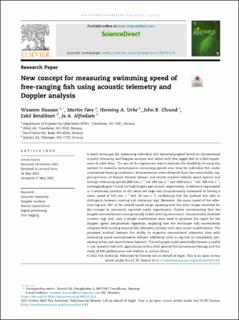| dc.contributor.author | Hassan, Waseem | |
| dc.contributor.author | Føre, Martin | |
| dc.contributor.author | Urke, Henning Andre | |
| dc.contributor.author | Ulvund, John Birger | |
| dc.contributor.author | Bendiksen, Eskil | |
| dc.contributor.author | Alfredsen, Jo Arve | |
| dc.date.accessioned | 2023-03-13T09:31:13Z | |
| dc.date.available | 2023-03-13T09:31:13Z | |
| dc.date.created | 2022-09-09T09:45:13Z | |
| dc.date.issued | 2022 | |
| dc.identifier.citation | Biosystems Engineering. 2022, 220 103-113. | en_US |
| dc.identifier.issn | 1537-5110 | |
| dc.identifier.uri | https://hdl.handle.net/11250/3057874 | |
| dc.description.abstract | A novel technique for measuring individual fish swimming speed based on conventional acoustic telemetry and Doppler analysis was tested with live tagged fish in a field experiment at a fish farm. The aim of the experiment was to evaluate the feasibility of using this method to measure instantaneous swimming speeds over time for individual fish under commercial farming conditions. Measurements were obtained from two acoustically tagged specimen of farmed Atlantic salmon and results showed realistic speed spectra and average swimming speeds (880 mm s−1 std. 590 mm s−1 and 1080 mm s−1 std. 560 mm s−1, corresponding to 1.4 and 1.6 body lengths per second, respectively). A reference tag moored in a stationary position in the same sea cage was simultaneously measured as having a mean speed of 110 mm s−1 (std. 80 mm s−1), confirming that the method was able to distinguish between moving and stationary tags. Moreover, the mean speed of the reference tag was 10% of the overall speed range, agreeing with the error ranges observed for the concept in previously reported model experiments, further corroborating that the Doppler measurements were genuinely linked with tag movement. Commercially available acoustic tags with only a simple modification were used to generate the signal for the Doppler speed computation algorithm, implying that the technique will conveniently integrate with existing acoustic fish telemetry systems with only minor modifications. The proposed method features the ability to augment conventional telemetry data with swimming speed measurements without additional costs in tag size or complexity, promoting richer and more diverse datasets. The technique could potentially become a useful in-situ research tool with applications within both general fish behavioural biology and the study of fish performance and welfare in marine farms. | en_US |
| dc.language.iso | eng | en_US |
| dc.publisher | Elsevier B. V. | en_US |
| dc.rights | Navngivelse 4.0 Internasjonal | * |
| dc.rights.uri | http://creativecommons.org/licenses/by/4.0/deed.no | * |
| dc.title | New concept for measuring swimming speed of free-ranging fish using acoustic telemetry and Doppler analysis | en_US |
| dc.title.alternative | New concept for measuring swimming speed of free-ranging fish using acoustic telemetry and Doppler analysis | en_US |
| dc.type | Peer reviewed | en_US |
| dc.type | Journal article | en_US |
| dc.description.version | publishedVersion | en_US |
| dc.source.pagenumber | 103-113 | en_US |
| dc.source.volume | 220 | en_US |
| dc.source.journal | Biosystems Engineering | en_US |
| dc.identifier.doi | 10.1016/j.biosystemseng.2022.05.013 | |
| dc.identifier.cristin | 2050155 | |
| cristin.ispublished | true | |
| cristin.fulltext | original | |
| cristin.qualitycode | 1 | |

